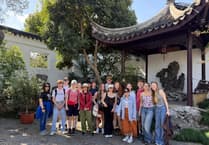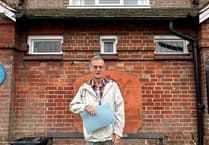Thirty people gathered at Lynchmere Cricket Pavilion on May 9 for a walk and talk volunteering event to see how they could help maintain rare lowland heaths and wildflower meadows.
Volunteers visited and learned about a 17th-century barn whose walls contain some Normandy stone in the event organised by The Lynchmere Society.
They heard about the nearby community orchard containing 36 traditional apple trees including the West Sussex Crawley Beauty and Egremont Russet, and discovered how Belted Gallows cows graze the fields and commons to improve wildlife.
Following the tour Christopher Tibbs, who chairs the society’s land management committee, described 3,000 years of lowland heath history, from its creation, neglect and decline to its rescue today.
He emphasised the importance of controlling rhododendron, western hemlock, scrub and bracken to let heather thrive.
Organic farmer Edwin Brooks explained how cows’ conservation grazing kept birch and bracken under control, and how their nibbling gorse and heather stimulated biodiversity and enhanced wildlife.
Botanist and ecologist Bruce Middleton said he would create a “botanical baseline” of the commons and meadows, building on the society’s 40-year habitat records.
He will organise workshops to train volunteers to find and record flora, fauna, fungi, birds, mammals, insects, reptiles and amphibians which depend on this habitat.
Society chairman Mike McCart said: “The evening was a great success. We plan to hold more volunteer events during the summer and autumn to build wider community involvement to conserve this precious habitat.”
To find out more visit www.thelynchmeresociety.org





Comments
This article has no comments yet. Be the first to leave a comment.